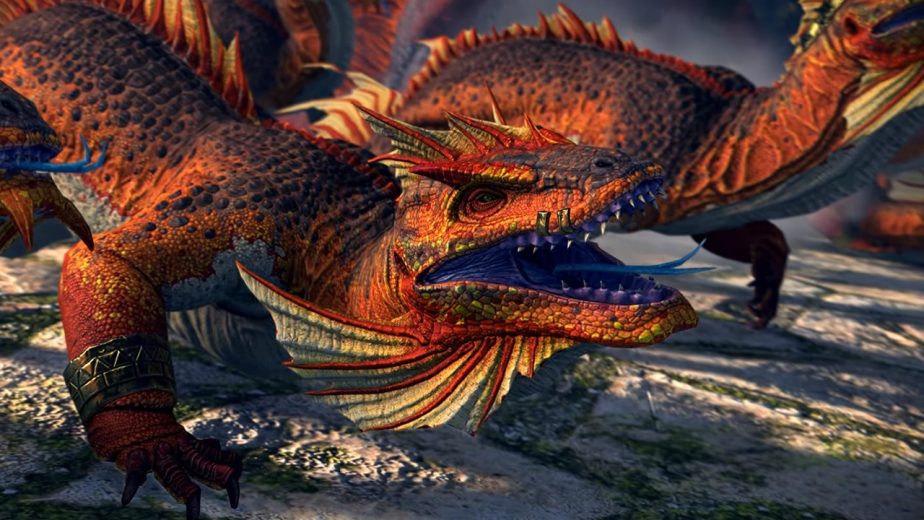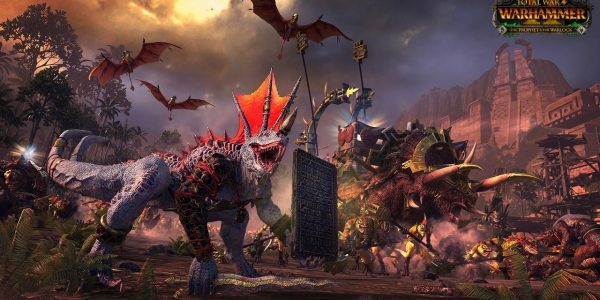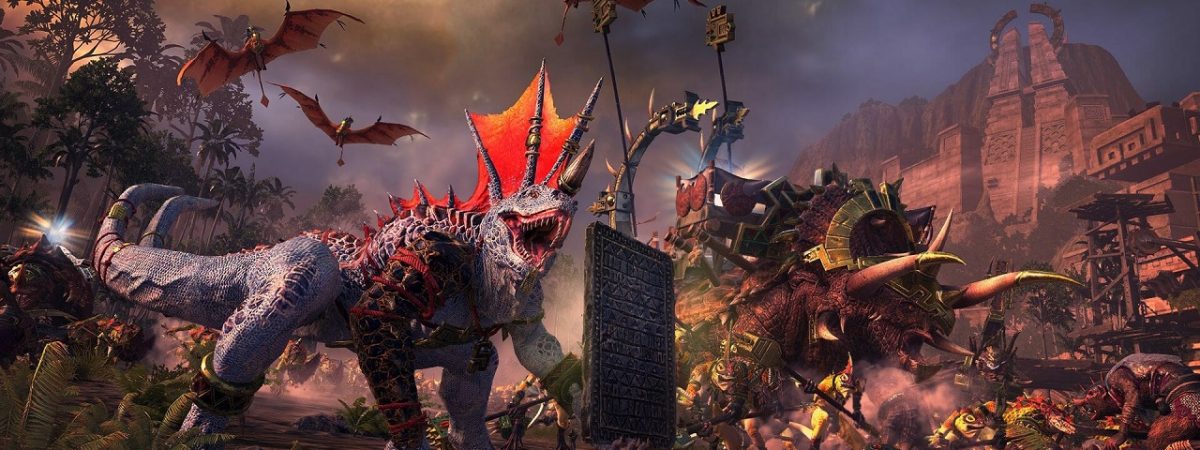Last week, Creative Assembly announced The Prophet and The Warlock; the next Lord pack DLC for Total War: Warhammer 2. The DLC will include major expansions of both the Lizardmen and Skaven factions, with a new Legendary Lord and new units coming to both. Shortly before the announcement, I had the opportunity to visit Creative Assembly’s studio and interview developers about the new expansion. After speaking with two of the project’s Designers about the new content, I was able to speak with Lead Character Artist Baj Singh and Animator Eva Seyeux about the incredible art and animation work that went into The Prophet and The Warlock!
The Prophet and The Warlock: Art and Animation Interview
Before we get into any big questions, could you introduce yourselves and explain what you do here at Creative Assembly?
Baj Singh: “Yeah, so I’m Baj Singh, I’m the Lead Character Artist on the Total War: Warhammer franchise.”
Eva Seyeux: “I’m Eva Seyeux, and I’m an Animator for Warhammer.”
Great. So, when you start work on a DLC like The Prophet and The Warlock, what sort of sources do you use to start designing and working on things?
BS: “So, we generally go from Games Workshop miniatures and illustrations. So, we’ll take the entire roster and we’ll compress their miniatures into, like, a very basic thumbnail form, where we’ll quickly sketch them out, just to kind of get feedback from them and make sure that we’re on track to fully design and render out the final concepts.”
ES: “Yes, for us we do the same; we start with the miniature and the lore and what special attacks or special abilities which creatures have, and then we go to the forums and see what the players are expecting from each character. Then, depending on the creature, we just find different references.”
Given the addition of Tehenhauin and the Cult of Sotek, did you go back to the old original Lustria sourcebook for Games Workshop’s range, which I think is where he originated?
BS: “Yes. So, we generally ask them for as many references as they can; it saves us having to go through all the army books and try and find all the different images. It’s like, if they’ve got them at hand, if they’ve got renders of the miniatures from different angles; we try and get as much from them as possible, just so it helps us retain the feel of their original miniatures as closely as possible, and then we take that and we make sure it fits within the Total War universe as well and that they merge well together.”
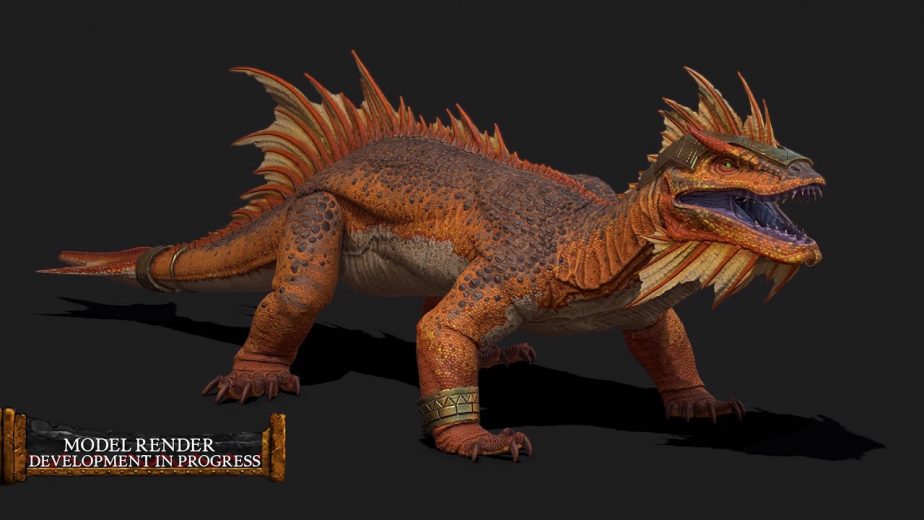
The design of a DLC like this clearly pits one faction against another. Do you work on the design of the two factions simultaneously as part of one larger design?
BS: “The visual design, yeah. So, we’ll outline it all in one go, in one pass, and then we’ll do each race in passes. Rather than trying to work on one intricately-detailed unit and then focus on the other ones afterwards, we’ll do it all piecemeal. So, yeah, small… kind of like, looking at it from a distance then looking at it closer and closer and seeing more and more detail with each render and each pass.”
When it comes to the design of something like a new Legendary Lord, which is obviously going to define the DLC to a lot of people, how do you approach making that character and giving them the presence that they need to have?
BS: “I think that’s a mixture of both art and animation at that point. Obviously we have to make sure that we maintain what’s present in the lore, but with animation, because the models are static, there’s a lot more flexibility there to really make them pop and make them stand out.”
ES: “Yeah, we have a good indication, like, we know if this unit has like fireballs or this unit has this lightning attack, and then we just play around with it; they just give us a base and then we take it further. Like, ‘How cool can that be?'”
With this particular case, what sort of challenges were there in designing and animating Tehenhauin and Ikit Claw, to bring them into Total War: Warhammer 2?
BS: “I think with Tehenhauin, from a modelling perspective, it was fine. Ikit was a bit more tricky, because he’s quite mechanical, you know, he’s got a lot of wires and things going on, so especially with his claw, trying to make sure that that fit within the existing skeleton. That was probably the most challenging part for the art team.”
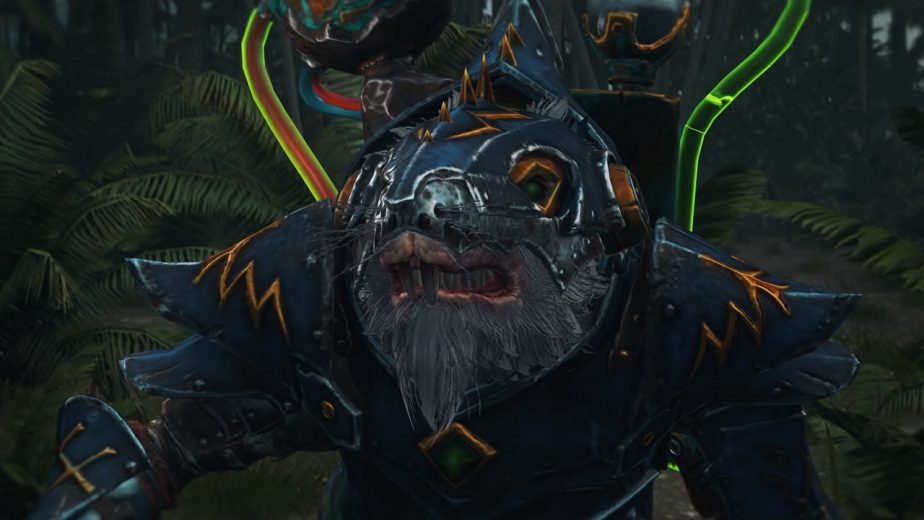
ES: “Yeah, for the animation team, Ikit was… he has so many things on him; he has his jetpack, he has his halberd and the flamethrower and the claw, and so it’s a lot of things that we wanted to use them all but all of them being still visible with the VFX, like, from long-distance, from close. So, it was, ‘OK, how can we make him super visible and really badass as well,’ because he has so many effects we can play with.”
When you have a character like that, do you start with the Legendary Lord and then think about how that’s going to influence the design for the units that are coming along with them, or is it one big project?
BS: “Yeah, so in this case, in the example of Ikit, we designed the Warlock Master to be very similar. So, he’s a new Lord that’s going to be introduced for this pack, and he’s a mixture of Ikit as well as the Warlock-Engineer, so it’s trying to get some of those design elements from the Legendary Lord integrated into the rest of the units. It’s the same with Tehenhauin. The Red-Crested Skinks in particular, just trying to make sure that the visual similarities are present in each of those units so that it feels part of the same race pack, rather than their own distinct units that could be fit anywhere.”
Certainly. Is that the same for animating them; building sort of a cohesive aesthetic for the new units?
ES: “Yes. We have from Warhammer 1 and 2, we built the races and for the Lizardmen, we try to have the same feeling of being very agile but depending on how their personal abilities work, we tweak this to be more cohesive. So yeah, Tehenhauin had to be agile but still have his plaque. The Red-Crested Skinks still have to be agile but they have these big weapons, and so they use it to their advantage, to use the weight to give them power, and things like that. And with the Skaven it’s the same, because they’re all jittery, but they have to be jittery in their own ways. But we still have a good base, and then we improve every character.”
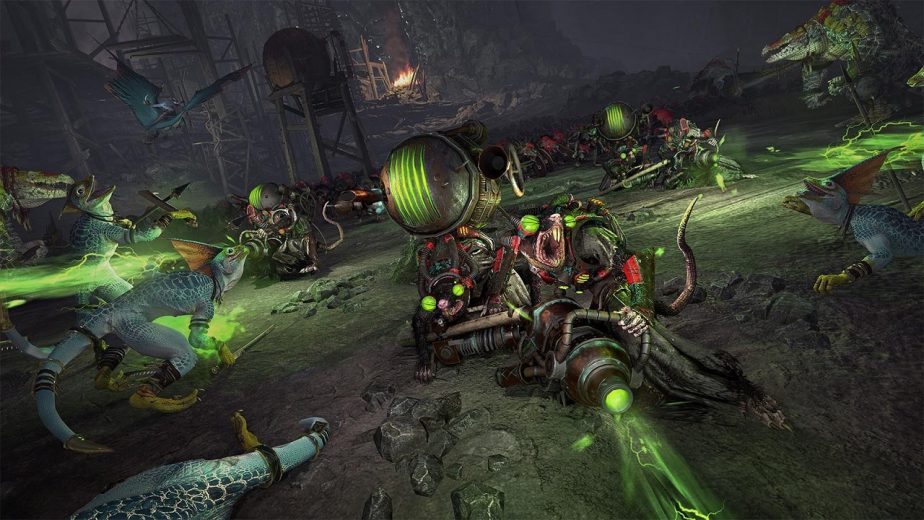
Yes. I suppose with both of these races, there’s kind of unique challenges when it comes to animation because of the weight and size of some of the things, like the Skaven war machines. When it comes to – as we’ve already seen in the trailer – the addition of the Doom-Flayers to the roster, is the speed of something like that a challenge to animate?
ES: “It was a very, like, this one was testy; all along, it was back and forth between you guys [the Art department], the animation, and the designers. ‘How do we make the blades work? What’s the speed of the thing? How is it going through the enemies? Is it going through them or not?’ It was all those little things that we had to sort out, but I think it’s just a case of communication between the teams.”
With things like Tehenhauin, we’d certainly expect to see more of an emphasis on themes like sacrifice that fans haven’t necessarily seen in the Lizardmen up until now. So, is that something which factors into the visual design, the new aspects of each faction, etc.?
BS: “Yeah, so we kind of went for the ‘science vs. religion’ approach in this case. So, it was very kind of… what kind of symbology could we approach each design, again to make sure that we maintain Games Workshop’s original design as well. So, yeah, obviously we take a lot of those glow-y, almost Frankenstein-esque elements in the new Skaven units, so there’s a lot of pulsating energy running through them, whereas it’s more spell-focused on the Lizardmen’s side. It’s very much like iconography and traditionalism and textures to kind of get that look in; very ancient-looking, very religious-looking.”
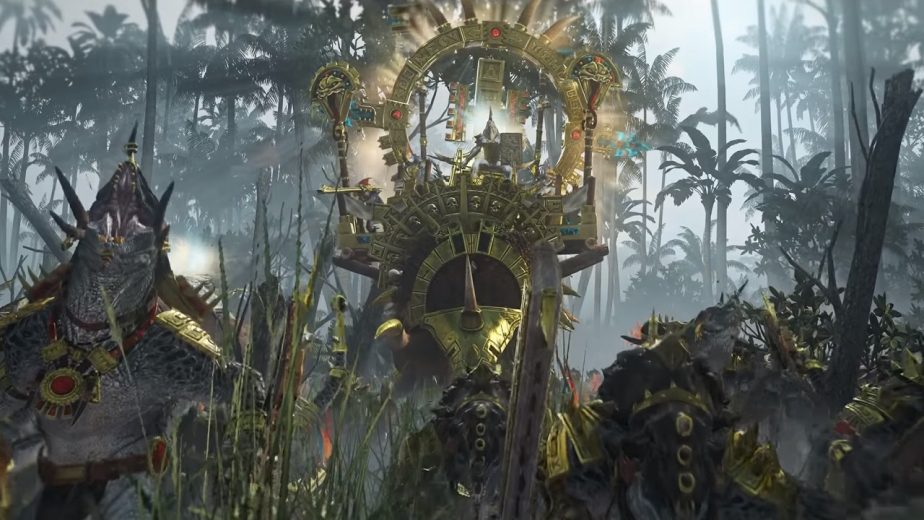
With the Skaven, obviously you’re bringing in a lot of new content that’s kind of machine-themed; have the Skaven always been a bit tricky when it comes to animation, because of things like the Hell Pit Abomination and the Doomwheel; those kind of crazy machines, and with this just adding more, does it make it difficult to work with?
ES: “It’s one piece at a time, [laughs] so yeah, it’s really… they’re all challenging, but the Hell Pit was in his own way because it was a very complicated rig, and like, what kind of references do we find for that guy? But the Doomwheel is like a motorbike and it was more technical issues, like, ‘How do we make that look good?’ because that’s not something we’ve really had before. So it was figuring out the technical part of that one. So, every units has its own challenge.”
With this particular DLC, was there anything that was particularly challenging to work with, or to kind of bring to life in the game, from either an art or an animation perspective?
BS: “For us, it was the Warlock Master, just because it was a different way of doing something. We had to get claws onto an existing skeleton onto the existing Skaven skeleton, and so we had to try and make sure that we repurposed a Skaven’s fingers so it could also function as claws and make sure that things like the wrist could also function as kind of a rotational mechanism. So, it was a bit of work with both the technical animators and the animators to kind of get that working correctly.”
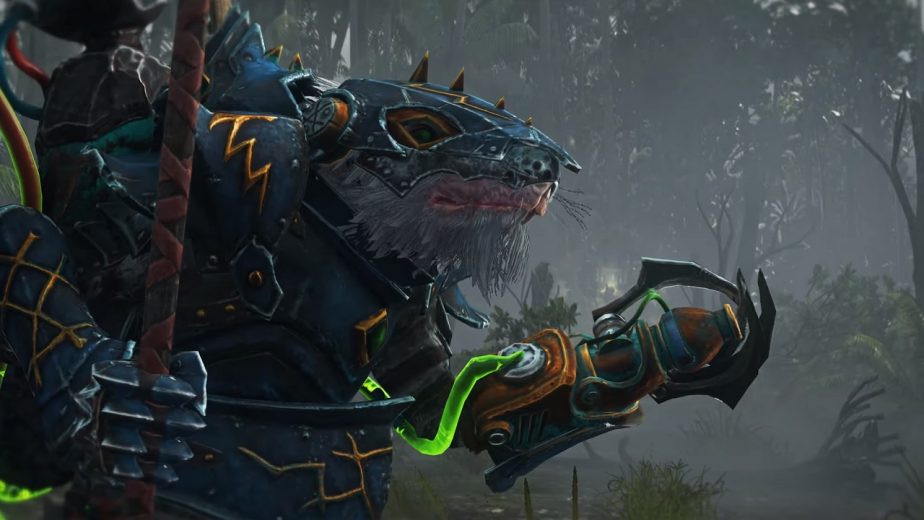
ES: “Yeah, for us we had some real challenges, like, for example, Kroak. Because he’s dead, it was like, ‘How do we make him interesting?’ because he’s just, well, he’s dead on his chair. So, it was coming up with ideas to make him look alive, so he has these attacks where he’s actually a ghost going over his chair.”
Yeah, I heard little bit about that in the last interview! I’d love to hear a bit more about how you approached designing Kroak, given that he’s so static as a model.
BS: “Well, for the visual side, again, a lot of that work was already done. It was trying to make sure that we got him to attack, and so we tried to think of the ethereal side and basically take that character, give him an ethereal look, and then use that to attack while keeping the dead version of Kroak centred in the middle of his chair. So, yeah, a lot of the designs… I think we kind of got that sussed, and it was more the animation more than anything else.”
When it comes to his approach, obviously we’ve already got Slann in the game with Mazdamundi, so was there a challenge to make sure that he felt distinct, given that he’s essentially the same kind of creature in the same kind of chair?
BS: “I think that’s where the ethereal version came in, it was ‘How can we make this different to Mazdamundi?’ and that was the approach that we took with it.”
With what’s going into The Prophet and The Warlock, are there any particular units or parts of it that you think are really stand-out, or that you really enjoyed working with?
BS: “I think probably the Doom-Flayer and the Warlock Master for me; it’s mainly the Skaven units. I mean, I’m more of a Skaven fan than a Lizardmen fan anyway, so yeah. [To Eva] I know you like the big lizards, but I like the smaller rats. So, yeah, the kind of technological ones for me really stand out, especially Ikit. I mean, Ikit’s just… the way he was put together worked really well.”
ES: “Well, I worked a lot on the Salamanders, so that’s my little baby. I mean, we’re still working on this unit, so, and it was a lot of work and a lot of fun, so this, yeah; the Salamanders. They’re cool.”
